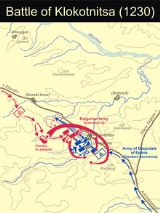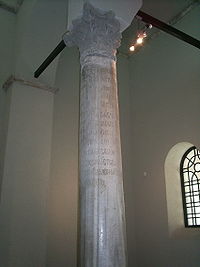
Battle of Klokotnitsa
Encyclopedia
The Battle of Klokotnitsa occurred on 9 March 1230 near the village of Klokotnitsa
(today in Haskovo Province
, Bulgaria
). As a result, the Second Bulgarian Empire
emerged once again as the most powerful state in Eastern Europe
and the power of the Despotate of Epirus
faded. The battle is often considered by historians to be the luckiest and most fruitful in Bulgarian military history.
of Epirus. Secured by the treaty, Theodore managed to conquer Thessalonica from the Latin Empire
, as well as Bulgarian lands in Macedonia
including Ohrid
. After the death of the Latin emperor
Robert of Courtenay
in 1228, Ivan Asen II was considered the most probable choice for regent of Baldwin II
. Theodore thought that Bulgaria was the only obstacle left on his way to Constantinople
and in the beginning of March 1230 he invaded the country, breaking the peace treaty and without a declaration of war.
 Theodore Komnenos summoned an enormous army including western mercenaries. He was so confident for his victory that he took the whole royal court with himself including his wife and children. His army moved slowly and plundered the villages on its way. When the Bulgarian tsar learned that the state was invaded, he gathered a small army of a few thousand men and quickly marched southwards. For four days the Bulgarians
Theodore Komnenos summoned an enormous army including western mercenaries. He was so confident for his victory that he took the whole royal court with himself including his wife and children. His army moved slowly and plundered the villages on its way. When the Bulgarian tsar learned that the state was invaded, he gathered a small army of a few thousand men and quickly marched southwards. For four days the Bulgarians
covered a distance three times longer than Theodore's army for a week.
On March 9, the two armies met near the village of Klokotnitsa. It is believed that Ivan Asen II ordered the broken mutual protection treaty to be stuck on his spear and used as a flag. He was a good tactician and managed to surround the enemy who was surprised to meet the Bulgarians so soon. The battle continued until sunset. The Epirotians were completely defeated, only a small force under the despot's brother Manuel managed to escape the battlefield. The rest were killed in the battle or captured, including the royal court of Epirus and Theodore himself.
"In the year 6738 (1230), third indiction
. John Asen in God Christ true Tsar and sovereign of the Bulgarians, son of the old Tsar Asen, raised from the foundations and decorated with art this holy church in the name of the Holy 40 Martyrs, with the help of whom in the twelfth year of my reign when this temple was being decorated. I made war in Byzantium and defeated the Greek army and captured their Tsar, Kyr Teodore Komnenos, together with all his bolyars. And I occupied all of his land from Odrin (Adrianople) to Drach (Dyrrhachium), Greek and also Albanian and Serbian; and the towns around Constantinople and this very town were ruled by the Frizes (Latins), but they also subjugated to my empire; because they had no other Tsar but me and thanks to me they spent their days, because God ordered this, because without Him neither a deed, nor a word is done. Glory to Him forever, amen."
Klokotnitsa
Klokotnica is a village in southern Bulgaria near Haskovo. It has a population of 619 people .The village is famous for the great battle on 9 March 1230, between the Bulgarian tsar Ivan Asen II and the Byzantine Greek despot Theodore Komnin of Epirus...
(today in Haskovo Province
Haskovo Province
Haskovo Province is a province in southern Bulgaria, neighbouring Greece and Turkey to the southeast, comprising parts of the Thracian valley along the river Maritsa. It is named after its administrative and industrial centre - the city of Haskovo...
, Bulgaria
Bulgaria
Bulgaria , officially the Republic of Bulgaria , is a parliamentary democracy within a unitary constitutional republic in Southeast Europe. The country borders Romania to the north, Serbia and Macedonia to the west, Greece and Turkey to the south, as well as the Black Sea to the east...
). As a result, the Second Bulgarian Empire
Second Bulgarian Empire
The Second Bulgarian Empire was a medieval Bulgarian state which existed between 1185 and 1396 . A successor of the First Bulgarian Empire, it reached the peak of its power under Kaloyan and Ivan Asen II before gradually being conquered by the Ottomans in the late 14th-early 15th century...
emerged once again as the most powerful state in Eastern Europe
Eastern Europe
Eastern Europe is the eastern part of Europe. The term has widely disparate geopolitical, geographical, cultural and socioeconomic readings, which makes it highly context-dependent and even volatile, and there are "almost as many definitions of Eastern Europe as there are scholars of the region"...
and the power of the Despotate of Epirus
Despotate of Epirus
The Despotate or Principality of Epirus was one of the Byzantine Greek successor states of the Byzantine Empire that emerged in the aftermath of the Fourth Crusade in 1204. It claimed to be the legitimate successor of the Byzantine Empire, along with the Empire of Nicaea, and the Empire of Trebizond...
faded. The battle is often considered by historians to be the luckiest and most fruitful in Bulgarian military history.
Origins of the conflict
Around 1221–1222 the Bulgarian Emperor Ivan Asen II made an alliance with Theodore Komnenos DoukasTheodore Komnenos Doukas
Theodore Komnenos Doukas was ruler of Epirus from 1215 to 1230 and of Thessalonica from 1224 to 1230.-Life:...
of Epirus. Secured by the treaty, Theodore managed to conquer Thessalonica from the Latin Empire
Latin Empire
The Latin Empire or Latin Empire of Constantinople is the name given by historians to the feudal Crusader state founded by the leaders of the Fourth Crusade on lands captured from the Byzantine Empire. It was established after the capture of Constantinople in 1204 and lasted until 1261...
, as well as Bulgarian lands in Macedonia
Macedonia (region)
Macedonia is a geographical and historical region of the Balkan peninsula in southeastern Europe. Its boundaries have changed considerably over time, but nowadays the region is considered to include parts of five Balkan countries: Greece, the Republic of Macedonia, Bulgaria, Albania, Serbia, as...
including Ohrid
Ohrid
Ohrid is a city on the eastern shore of Lake Ohrid in the Republic of Macedonia. It has about 42,000 inhabitants, making it the seventh largest city in the country. The city is the seat of Ohrid Municipality. Ohrid is notable for having once had 365 churches, one for each day of the year and has...
. After the death of the Latin emperor
Latin Empire
The Latin Empire or Latin Empire of Constantinople is the name given by historians to the feudal Crusader state founded by the leaders of the Fourth Crusade on lands captured from the Byzantine Empire. It was established after the capture of Constantinople in 1204 and lasted until 1261...
Robert of Courtenay
Robert of Courtenay
Robert of Courtenay , emperor of the Latin Empire, or of Constantinople, was a younger son of the emperor Peter II of Courtenay, and a descendant of the French king, Louis VI, while his mother Yolanda of Flanders was a sister of Baldwin and Henry of Flanders, the first and second emperors of the...
in 1228, Ivan Asen II was considered the most probable choice for regent of Baldwin II
Baldwin II of Constantinople
Baldwin II of Courtenay was the last emperor of the Latin Empire of Constantinople.He was a younger son of Yolanda of Flanders, sister of the first two emperors, Baldwin I and Henry of Flanders...
. Theodore thought that Bulgaria was the only obstacle left on his way to Constantinople
Constantinople
Constantinople was the capital of the Roman, Eastern Roman, Byzantine, Latin, and Ottoman Empires. Throughout most of the Middle Ages, Constantinople was Europe's largest and wealthiest city.-Names:...
and in the beginning of March 1230 he invaded the country, breaking the peace treaty and without a declaration of war.
The battle

Bulgarians
The Bulgarians are a South Slavic nation and ethnic group native to Bulgaria and neighbouring regions. Emigration has resulted in immigrant communities in a number of other countries.-History and ethnogenesis:...
covered a distance three times longer than Theodore's army for a week.
On March 9, the two armies met near the village of Klokotnitsa. It is believed that Ivan Asen II ordered the broken mutual protection treaty to be stuck on his spear and used as a flag. He was a good tactician and managed to surround the enemy who was surprised to meet the Bulgarians so soon. The battle continued until sunset. The Epirotians were completely defeated, only a small force under the despot's brother Manuel managed to escape the battlefield. The rest were killed in the battle or captured, including the royal court of Epirus and Theodore himself.
Ivan Asen II's Tarnovo Inscription
In order to commemorate the battle, the Bulgarian emperor had an inscription carved in one of the marble columns of the church "Holy Forty Martyrs" in the capital of the Bulgarian empire Great Tarnovo. Among all existing documents the text of this inscription is the most accurate evidence of the outcome and the aftermath of the battle:"In the year 6738 (1230), third indiction
Indiction
An indiction is any of the years in a 15-year cycle used to date medieval documents throughout Europe, both East and West. Each year of a cycle was numbered: first indiction, second indiction, etc...
. John Asen in God Christ true Tsar and sovereign of the Bulgarians, son of the old Tsar Asen, raised from the foundations and decorated with art this holy church in the name of the Holy 40 Martyrs, with the help of whom in the twelfth year of my reign when this temple was being decorated. I made war in Byzantium and defeated the Greek army and captured their Tsar, Kyr Teodore Komnenos, together with all his bolyars. And I occupied all of his land from Odrin (Adrianople) to Drach (Dyrrhachium), Greek and also Albanian and Serbian; and the towns around Constantinople and this very town were ruled by the Frizes (Latins), but they also subjugated to my empire; because they had no other Tsar but me and thanks to me they spent their days, because God ordered this, because without Him neither a deed, nor a word is done. Glory to Him forever, amen."

